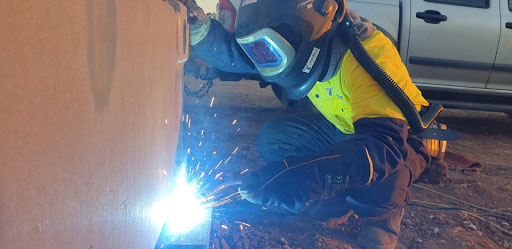From an outsider’s perspective, the metals used in welding and fabrication all look the same. Apart from color and luster, there really isn’t much an average person can do to discern from different types of metals and alloys – and even those criteria are difficult to distinguish from one another. Because of that, many people fail to predict how much money they actually have to pay for metal welding services. One of the main factors that contribute to the cost of the services of a welding company is the type of metal that will be used for the project. Different metals vary in difficulty when it comes to welding and fabrication, and some are expensive to procure as well. This blog addresses that concern by providing a simple distinction between the common types of metal used in welding and fabrication.
Choosing the Correct Metal for Fabrication
Metal fabricators work with all sorts of metals, and it is important to know the distinction between each and every one of them. In terms of practicality, there are three factors that distinguish these metals from each other: strength, weight, and resistance to corrosion.
Aluminum
The most abundant metal and the third most abundant element on the earth’s crust is aluminum. However, because of its highly reactive property, it is rarely found in its purest form. The main source of aluminum in the world is bauxite, a mineral that is found in places like Australia and South America. It is lightweight, non-corrosive, and is a good thermal and electrical conductor. But most importantly, it is cheap and easy to fabricate. Its only real downside is that it is prone to warping and bending due to stress. TIG welding and shielded metal arc welding are suitable techniques for aluminum welding. If you have a metal project that you want to be done, the welding services in Albury, can help you out.
Stainless Steel
Arguably among the most important alloys in the modern age, stainless steel can be found in almost every nook and cranny in the world where there are people around. Its strength and flexibility make it suitable for structural fabrication, but what truly sets it apart is its resistance to corrosion. Stainless steel contains an element known as Chromium which creates a protective oxide layer over the metal that prevents it from rusting. It is easy to weld material, and is usually cheaper than alternatives with similar properties. Utensils, window frames, roofs, and awnings are common objects found in a house that are partly or completely made through custom stainless steel fabrication.
Carbon Steel
Carbon steel is a high-strength alloy with a broad range of uses, particularly in the construction of buildings and other large structures. It is stronger than both aluminum and stainless steel, but lacks the resistance to corrosion. In order to prevent it from rusting, a zinc coating is usually applied. There are three main types of carbon steel, categorized based on their carbon concentration. Mild steel contains 0.05% – 0.25% concentration. Medium carbon steel contains 0.25% – 0.7% concentration. Finally, high carbon steel has a carbon concentration of 0.7% – 1.5%. Carbon steel is also used to build pressure vessels, but are far more difficult to weld compared to stainless steel and aluminum.
Titanium alloy
Often found in rockets, armor plating, aircrafts, and shipbuilding, titanium is an exceptionally strong metal but light welding metal that boasts high heat resistance, corrosion resistance, and tensile strength. Despite being the fourth most abundant metal in the earth’s crust, it can be notoriously expensive. In some cases, titanium is also used for biological implants because it does not react with the human body. Gas metal arc welding (GMAW) and TIG welding are both compatible welding techniques metal fabricators use for this alloy.
Cast Iron
Cast iron is also an iron-carbon alloy, but contains a much higher concentration of carbon than carbon steel. It is commonly found in the kitchen as frying pans and metal pots. It is a hard metal, but that comes at the expense of ductility and tensile strength. Besides the aforementioned, cast iron is used to build fences, gates, farm equipment, beekeeping equipment, and mining equipment. Shielded metal arc welding is one of the popular methods of welding this alloy, making it even more cost-efficient to work with when other factors are not important.
How TopWeld Can Help With Metal Fabrication Services in New South Wales
Topweld General Engineering is a metal fabrication and welding company offering high-quality custom metal fabrication services for a diverse range of clientele all across the state. Having been in the industry for over 2 decades, we have ample experience working with different industries such as housing, agriculture, manufacturing, and automotives. Regardless of the scope of a project, our talented craftsmen work diligently to produce impeccable results. Our specialties include stainless steel welding, aluminum welding, and sheet metal welding.
FAQ
What 3 metals are commonly welded?
Aluminum, stainless steel, and mild steel are metals that are commonly used in welding and fabrication. They are cheap, strong, and in the case of aluminum and stainless steel are resistant to corrosion.
What metal rod is used in welding?
Mild steel electrodes such as 7018, as well as 6013, 6011, 6010, 7014 are some of the most common rods used for welding and metal fabrication.
What are the 3 main fabrication techniques
There are three main welding techniques used in metal fabrication: shielded metal arc welding (stick welding), metal inert gas (MIG) welding, and Tungsten inert gas (TIG) welding.
What is the difference between welding and metal fabrication
Welding is a term used to refer to the process of joining two pieces of metal together by applying heat. Metal fabrication involves the cutting, bending, and assembly of metal which also involves welding to affix the pieces together.











